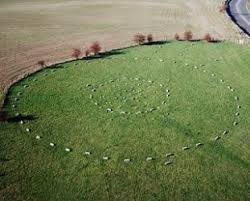The Standing Stones of Avebury Henge Circles

The stone circles of Avebury henge, in Wiltshire, England are among the largest and oldest in the British Isles. Their interpretation should be linked to that of the Stonehenge and Silbury sites.
The Avebury henge site
If we understand the levee surrounding the site, Avebury henge covers an area of approximately 15 hectares. This site consists of a huge outer ring, erected around 2500 BC, whose circumference is approximately 1,200 meters and the diameter of 427 meters. This circle initially included ninety-eight blocks of stone, placed vertically on a 6-meter-high embankment, but today only twenty-seven remain. Inside are two more circles. The smallest, to the north, dates from 2600 BC and its circumference is 98 meters. It once counted twenty-seven stones, of which only four have come down to us. The southern circle, from the same period, has a circumference of 104 meters and once included twenty-nine stones. Five are still standing.
Unlike Stonehenge, the sandstone of Avebury comes from a nearby quarry, making it easier to transport. The megaliths measure from 2.10 to 5.50 meters high and weigh up to 40 tonnes. To prevent them from overturning, they are buried at a depth of 15 to 60 centimeters. The obelisk, the largest stone on the site of Avebury henge, must have been 5.50 meters, but it was destroyed in the 18th century. Two alleys, also made of stone blocks, leave the large outer circle.
The monument undoubtedly remained in relatively good condition until the 14th century, when the Church ordered the destruction of this place of worship considered to be “pagan”. During the 17th and 18th centuries, these stones were got rid of to gain new cultivable land or used to build new houses. This phenomenon is well known and many monuments had to suffer from it. The Colosseum in Rome and the Roman Wall of Tarragona, Spain, were dismantled for the same purpose.
Discovery and interpretation of Avebury stone circles

It was John Aubrey who, in 1648, recognized in this set of stones a megalithic circle from prehistoric times. As with Stonehenge, he saw in this monument a sanctuary erected by druids. Later, around 1720, the scientist William Stukeley also attributed the paternity of this site to Druids. In 1930, the National Trust had many stones replaced. Of the one hundred and fifty-four megaliths that originally counted on the site of Avebury, thirty-six are now in place. If one also counts the stone alleys, the site formerly included six hundred megaliths.
William Stukeley was the first to notice that Avebury's plan looked like a coiled serpent, a symbol of alchemy. The head and the tail of this immense snake would be represented by the two stone alleys, 17 meters wide, which stretch across the countryside for 2.5 kilometers. One of these two alleys leads to another circle of stones, called the Sanctuary.
Avebury, pagan temple of fertility
For Terence Meaden, the Avebury site was a sanctuary dedicated to the Moon and the Sun, symbolized by the two circles. The moon would represent femininity or Terra the goddess of the Earth, the sun would represent masculinity or Taran the god of Heaven. At the summer solstice, Terra and Taran merge to signify the renewal of the world. To support his theory, Meaden argues that in all rites devoted to fertility, the circle is always the symbol of the feminine principle, while fine standing stones symbolize the masculine principle. Avebury henge would therefore be a pagan temple dedicated to fertility.
The different names of the goddess of the Earth and the god of Heaven
Terra is an Indo-European name which designates the goddess of the Earth. In India, she was called Prithvi, the Etruscans designated her by the name of Cel, for the Hebrews, she was Asherah, while she was called Terra Mater in Rome.
The male equivalent of Terra was Taranis, god of Thunder and Rain. The Hittites called him Tarhun, the inhabitants of Andaman Island, Tarai. In Scandinavia, he was called Thor, Donar in Germany, while the Anglo-Saxons said Tunor.









































































































































































































































































































































